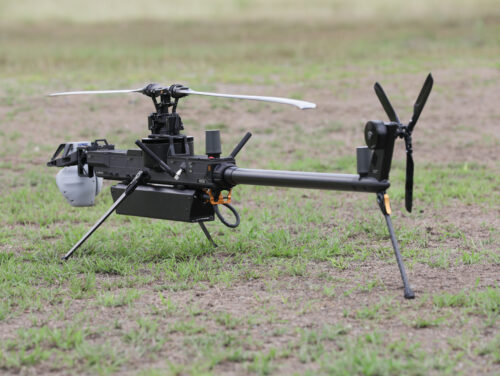The Anduril Ghost-X unmanned aircraft system made its training debut in the Philippines last week during Salaknib 2025, marking a significant milestone in both U.S. military drone deployment and Philippine-U.S. military cooperation.

Soldiers from the Philippine Army’s 5th and 7th Infantry Division and U.S. Army’s 25th Infantry Division engaged in a Subject Matter Expert Exchange (SMEE) focusing on Short-Range Reconnaissance (SRR) and Medium-Range Reconnaissance (MRR) Unmanned Aircraft Systems on Mar. 26, with the Ghost-X serving as the primary training platform.
The Ghost-X deployment comes remarkably soon after its selection by the U.S. Army. In Sept. 2024, the United States Army announced that Anduril’s Ghost-X UAS had been chosen for the Company Level Small Unmanned Aircraft System (sUAS) Directed Requirement following a competitive procurement process. Within less than seven months, the system has moved from selection to field deployment in training scenarios.
“Today’s exchange focused on employing UAS systems and how they contribute to the information collection matrix, helping us establish a common operational picture,” said U.S. Army Staff Sgt. Robert Catanesi, a platoon sergeant for robotics and autonomous systems assigned to the 2nd Infantry Brigade Combat Team, 25th Infantry Division.
The Ghost-X provides tactical reconnaissance advantages with its 90-minute cruise endurance and 25-kilometer operating range. Its single-rotor design accommodates up to 25 pounds of payload and includes weatherization features for operation in harsh environments. The system operates on Lattice, Anduril’s command and control software, which allows a single operator to control multiple aircraft simultaneously.
For the Philippine and U.S. forces at Salaknib, the Ghost-X training provided an opportunity to enhance interoperability through shared technology. Catanesi noted that Philippine soldiers demonstrated strong expertise in battlefield information preparation, with approaches that closely mirrored U.S. methods in adapting to emerging technologies.
The rapid fielding of Ghost-X aligns with the U.S. Army’s approach to modernization, which increasingly focuses on integrating commercial capability to Brigade Combat Teams. This approach helps inform requirements, doctrine, tactics, training, and maintenance concepts for the Army’s Medium Range Reconnaissance program.
“Our guys have been the unsung heroes of this transformation,” said Catanesi, referring to junior enlisted soldiers receiving hands-on training with the system. “They’ve been at the forefront of experimenting with these new systems, mastering them, and now teaching our allied partners.”
For Catanesi, the training in the Philippines carried personal significance beyond the technological aspects. “I love it here,” he said. “There’s a deep history between U.S. soldiers and the Philippine soldiers. Now it’s my turn to contribute.”
The joint training with advanced autonomous systems like Ghost-X represents a continuation of the long-standing military partnership between the Philippines and the United States, while simultaneously adapting that relationship to address modern security challenges in the Indo-Pacific region.
As Salaknib 25 continues, both forces are refining their tactical approaches with the Ghost-X, sharing expertise, and building a foundation for potential future operations involving autonomous systems. “We are never satisfied with the status quo,” Catanesi explained. “As partners we are always refining our tactics, questioning methods, and looking for better solutions.”
For more information, hit the Source below